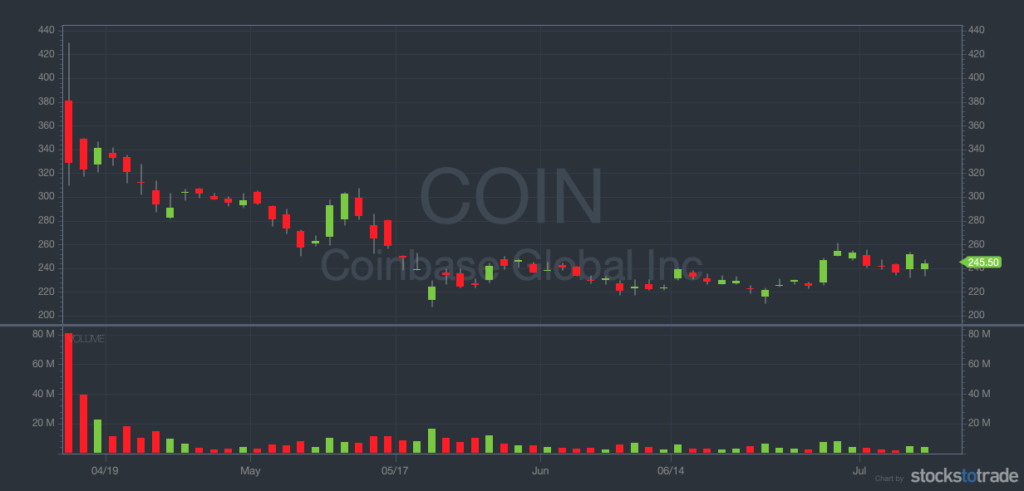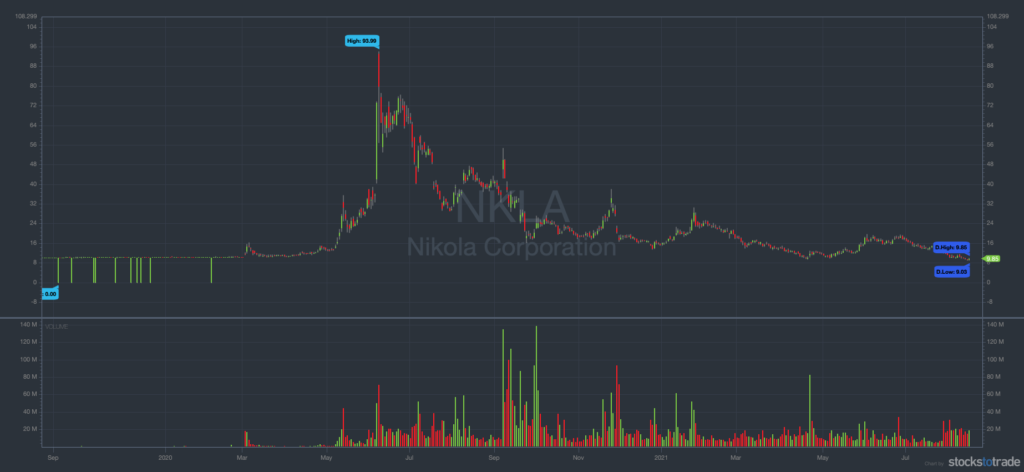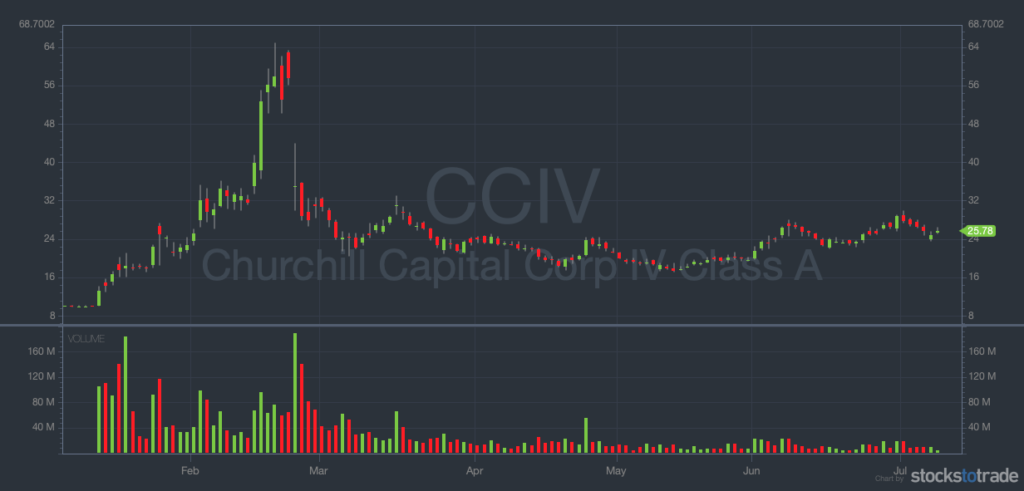Reverse Merger: Key Takeaways
- Reverse mergers are trending on the back of the SPAC boom…
- What a reverse merger really is…
- Why a good piece of news is one of the best catalysts for a stock…
If you want to trade reverse mergers, you first should learn what they are and how they affect price action. So let’s get right to it!
Table of Contents
- 1 What Is a Reverse Merger?
- 2 How Does a Reverse Merger Work?
- 3 Is a Reverse Merger Good?
- 4 Why Would a Company Go Through a Reverse Merger?
- 5 Reverse Merger Examples
- 6 Reverse Merger Advantages
- 7 Reverse Merger Drawbacks
- 8 What Are the Implications of a Reverse Merger for the Original Shareholders?
- 9 How to Spot a Reverse Merger
- 10 Reverse Merger: Conclusion
What Is a Reverse Merger?
Reverse mergers and IPOs are the two main routes a company can take to go public.
IPO is short for initial public offering. It’s the traditional way for a private company to go public. Along the way, it has to recruit an investment bank to issue its shares and determine the starting stock price.
Then it has to do a lot more — meet the listing requirements of its future exchange, fill out lots of paperwork, and drum up interest. Otherwise, it might have the kind of rough reception Coinbase had…

Coinbase Global Inc. (NASDAQ: COIN) YTD since April IPO (Source: StocksToTrade)
Reverse mergers simplify the process. They let the private company skip the uncertainty and cost of going the IPO route…
Sounds better for the company, right? That’s one reason they’re on the rise.
How Does a Reverse Merger Work?
They involve two companies — one that’s already listed.
The listed company is a shell company. It’s called that because all it has is an organizational structure … but doesn’t have a business. It only has an SEC registration.
When it reverse merges with the private company, that private company goes public IMMEDIATELY.
Typically, the shell company acquires the private company. But sometimes it’s the other way around.
Either way, there’s only one company left at the end of the transaction. And that company has both an underlying business — from the private company — and publicly traded shares from the shell company.
 The most common type of reverse merger these days is a SPAC, which stands for special-purpose acquisition company.
The most common type of reverse merger these days is a SPAC, which stands for special-purpose acquisition company.
Superstar investors like Chamath Palihapitiya are at the helm of the best-known SPACs. Their reputation helps get traders to buy into the new company.
These early adopters also get some perks in exchange for their trust. They get in on the ground floor of what might be an exciting new stock.
The SPAC might also issue warrants. These are like call options, but they’re given to SPAC investors for free. If the SPAC’s shares become valuable, investors can use these warrants to buy the stock at a cheaper price.
And if the SPAC tanks, you could use redemption rights to get your money back.
These are some of the reasons that SPAC-style reverse mergers are on the rise. From accounting for less than $1 billion/year a decade ago, they’re now outpacing IPOs.
Reverse mergers in 2020 gave us hot new stocks like DraftKings Inc. (NASDAQ: DKNG)…
Now let’s get to our main question — what do they mean for traders?
Is a Reverse Merger Good?
If you like Wall Street intrigue, all of these details are interesting. And they definitely matter to the stock’s prospects.
But when it comes down to it, I treat them in a similar way to IPOs.
With IPOs, there’s sometimes a spike … and then they slam hard. There’s no chart you can use to build a trading plan. So, you’re trading on the same hype as everyone else.
SPACs and other mergers have the same problem. Even if their charts go back weeks or months, it doesn’t mean much for when it becomes a public company.
When we build trades with the SteadyTrade Team, we look at several indicators.
Reverse merger stocks don’t have some of the biggest things we look for. They’re not former runners, so we can’t look at the way the stock behaves with news or heavy volume…
And they don’t have a chart, so we’re just guessing at support levels. That makes establishing risk much harder.
I always try to keep my students safe. I want them to be in it for the long haul. As much as possible, I want them to stay away from high-risk setups.
Twice a day, I discuss the best plays in the market with the SteadyTrade Team. The market isn’t made of stock tips and fleeting opportunities. If you miss out on a good trade, there’s another right around the corner.
If you need another perspective on the market, join the SteadyTrade Team!
Why Would a Company Go Through a Reverse Merger?
For companies, it makes a lot of sense.
A reverse merger requires fewer steps than an IPO to get the company where it’s going. And it takes a lot of uncertainty out of the process.
Instead of dealing with a volatile market, companies can get more certainty out of mergers. They also don’t have to raise capital in the same way. And companies can complete it in weeks instead of months or years.
If you want the most convincing proof, look at the list of reverse mergers in 2020 … SPAC deals outnumbered IPOs for the first time.
And upcoming reverse mergers like Virgin Orbit could paint a bright future…
These plays may be hot, but they’re not the safest plays. If you’re trading them when you hear their news, you may be too late.
That’s why it pays to have a great news scanner. StocksToTrade’s wide-ranging news scanner pulls news from all over the internet, tweets, earnings reports, and more. This can give you a crucial edge in detecting the rumors that make SPACs move.
If you’re looking for an extra edge, StocksToTrade has that too. We have two Wall Street pros running our Breaking News Chat. They’ll point you to the news that matters before the rest of the market catches on. That can make a difference in fast-moving trades like these.
Want to see if StocksToTrade works for you? Grab your 14-day STT + BNC trial now — it’s only $17 to start.
Reverse Merger Examples
Nikola Corp. (NASDAQ: NKLA) comes to mind. Its reverse merger in June 2020 signaled its price peak. Shortly after that, it tumbled to the point where it trades now, over 75% down from its peak.
Part of this is due to the overall downtrend in the EV sector … The other part is fallout from an activist short seller’s damaging report.
This is one notable example of a worrying trend in SPACs.
Renaissance Capital surveyed the SPACs that completed reverse mergers in 2015–2020. These companies delivered an average loss on investment of 9.6%.
The average return for traditional IPOs was 47.1% over the same period.
What does this tell us? Reverse mergers may be exciting, but that hasn’t translated to profits.
It isn’t just private companies that get a lot of value. SPAC founders also have a strong incentive to close their deals in the form of equity.
This trend isn’t going away. In fact, they’re hotter than ever.
Hot SPACs like Churchill Capital Corp IV (NYSE: CCIV) may have uneven charts…
But they’ve been good for trading. Before CCIV acquired luxury EV maker Lucid Motors, it ran from $10 a share to $58. The merger announcement coincided with its peak. One week later, it was trading at $28. Note that CCIV now trades under Lucid Group (NASDAQ: LCID).
Reverse Merger Advantages
They can be more efficient for companies. Let’s break down the reasons why.
There’s No Need for Registration
That’s a big one. When you do a reverse merger, you cut out the lengthy registration process for listing on an exchange.
The public shell companies or SPACs are already listed. The private company they acquire slides into their ticker slot … and bang, they’re in!
It’s Less Expensive
With registration comes expenses. Doing a share offering has more expenses. The underwriter’s 4%–7% cut is just the tip of the iceberg.
Sure, SPAC founders and shell-company owners take their cut too. But in the end, the company going public saves a lot.
They Save Time
There’s a saying you might have heard: Time is money. Traditional IPOs take six months to a year to plan. They can take that much time just for the process itself.
Reverse mergers take much less time. The difference to a company’s bottom line can be significant.
It Enables Entry to a Foreign Country
There are a lot of foreign companies that want access to U.S. markets. And traders want to be able to trade those companies’ stocks.
Reverse mergers from China-based companies have hit our markets hard. They account for 85% of foreign-originated SPACs in the 21st century.
Reverse Merger Drawbacks
Reverse mergers attracted a lot of scrutiny in the early 2000s. Their comeback in the SPAC era is partly due to the credibility that SPAC founders have given them…
But if you look deeper, they have some of the same problems.
Masquerading Public Shell Companies
One of the reasons reverse mergers haven’t boomed in the SPAC age is distrust of shell companies…
SPACs are also called blank-check companies. Investors basically hand them a blank check and trust they’ll use it in the way they say they will.
They don’t always do that.
Liquidation Mayhem
When a company goes public, they’re beholden to their new shareholders.
Let’s say that things go wrong. These shareholders might take drastic steps to make good on their investment.
Fraud Risk
We all want to make money. For some, that’s the entire game plan.
Other Drawbacks
Fraud is easy for reverse mergers because the incentives are great … and the safeguards are few.
What we’re basically talking about are backroom deals in the billions. Sometimes they’re great for everyone…
Other times the private company will cook its books. The shell company or SPAC will con its way into a few million. Then the traders and investors are left holding worthless stock.
The SPAC business model relies on investors to work.
SPACs basically do an IPO before they have a product. Their founder says, “I’m working on something … you want in?”
This founder is often a successful investor that people trust. Sometimes this trust is well-placed. Other times it isn’t. The original shareholders take a chance.
How to Spot a Reverse Merger
In the SPAC era, it’s easy to spot upcoming reverse mergers.
Like I mentioned before, the founders are usually high-profile investors. They’re trading on their own reputation to raise money. They do this by announcing their reverse merger intentions.
So staying current on financial news helps traders spot a reverse merger ahead of time. And that’s what you want to be able to do.
Tune into my Pre-Market Prep sessions to get a rundown of the day’s big movers. Check out this edition from early June. It features SPAC wunderkind Chamath Palihapitiya’s Clover Health Investments Corp. (NASDAQ: CLOV).
Reverse Merger Signals
The fundraising round is the biggest tip-off for an upcoming reverse merger.
It’s hard to keep it quiet when you’re raising upward of $500,000 for a company without a business.
Reverse Merger: Conclusion
Reverse mergers carry a lot of risk and opportunity…
In other words, they’re great trading vehicles. As traders, we LOVE volatility. But you have to know how to handle it to stay safe.
That means staying up to date on your market knowledge and trading education. Commit to that first. Then the next time reverse merger buzz comes your way, you’ll have your plan set.
How do you trade reverse mergers and SPACs? Do you prefer them to IPOs? Let me know in the comments — I love hearing from my readers!


